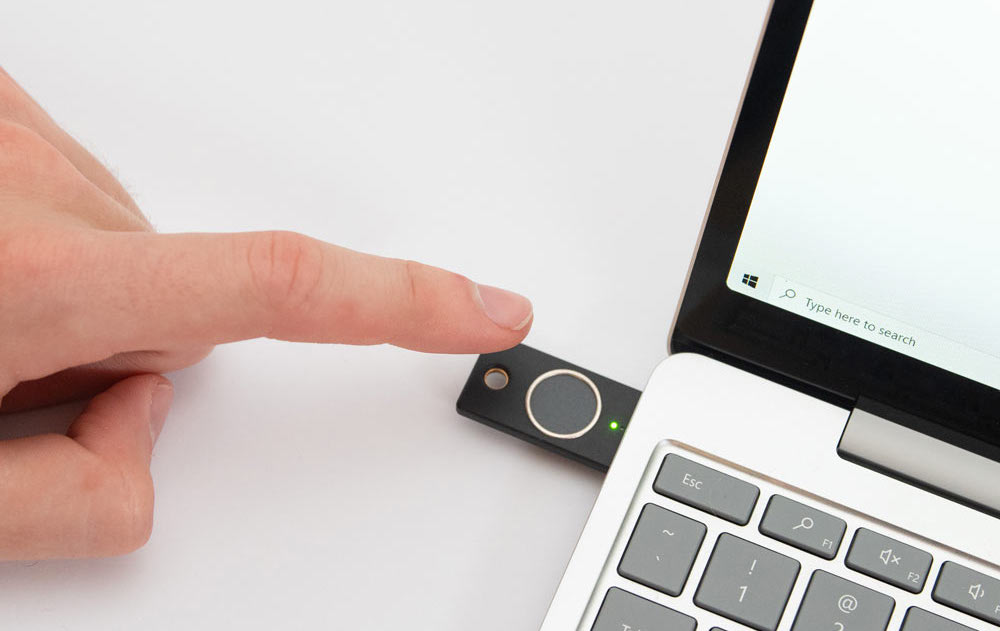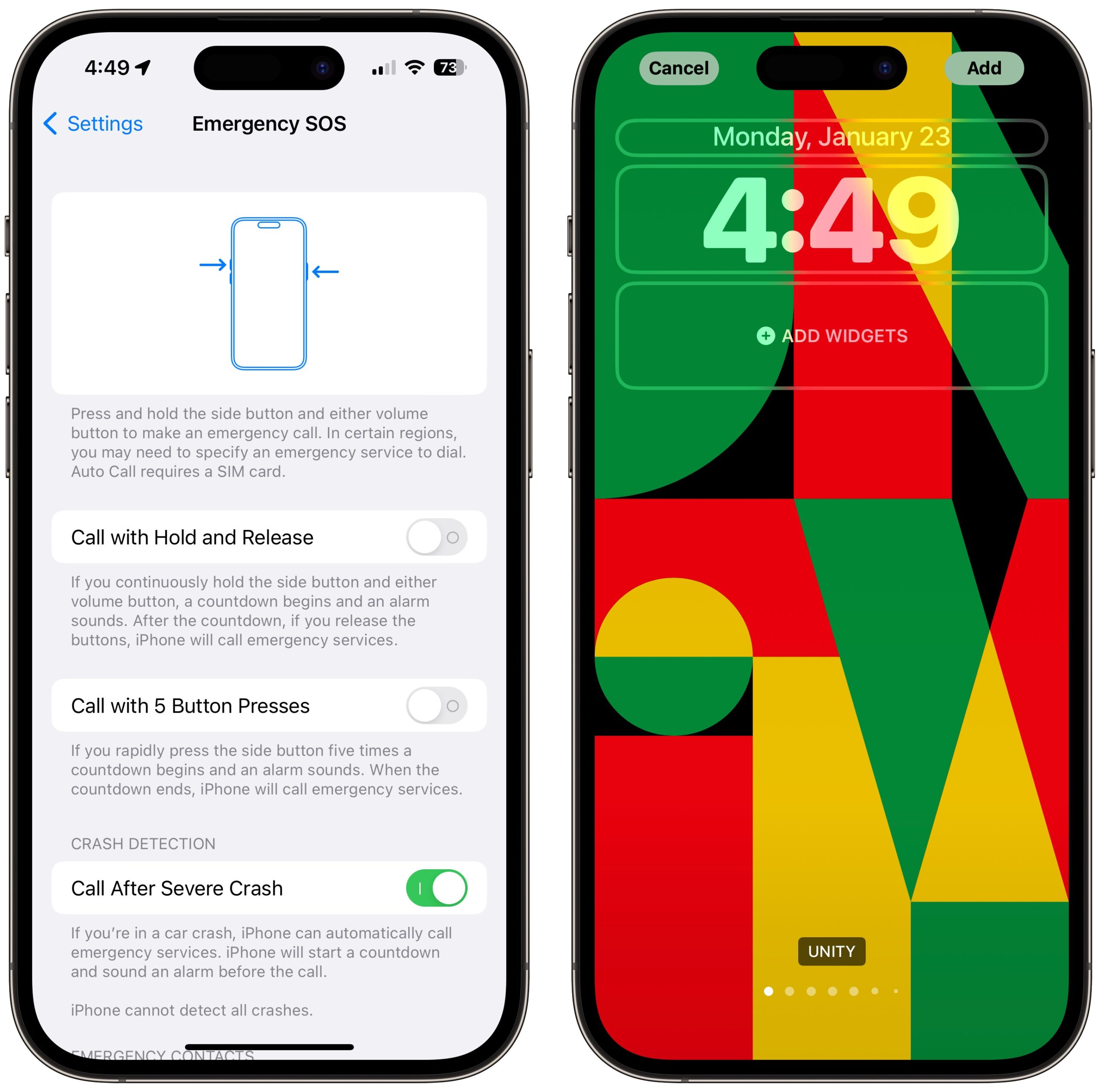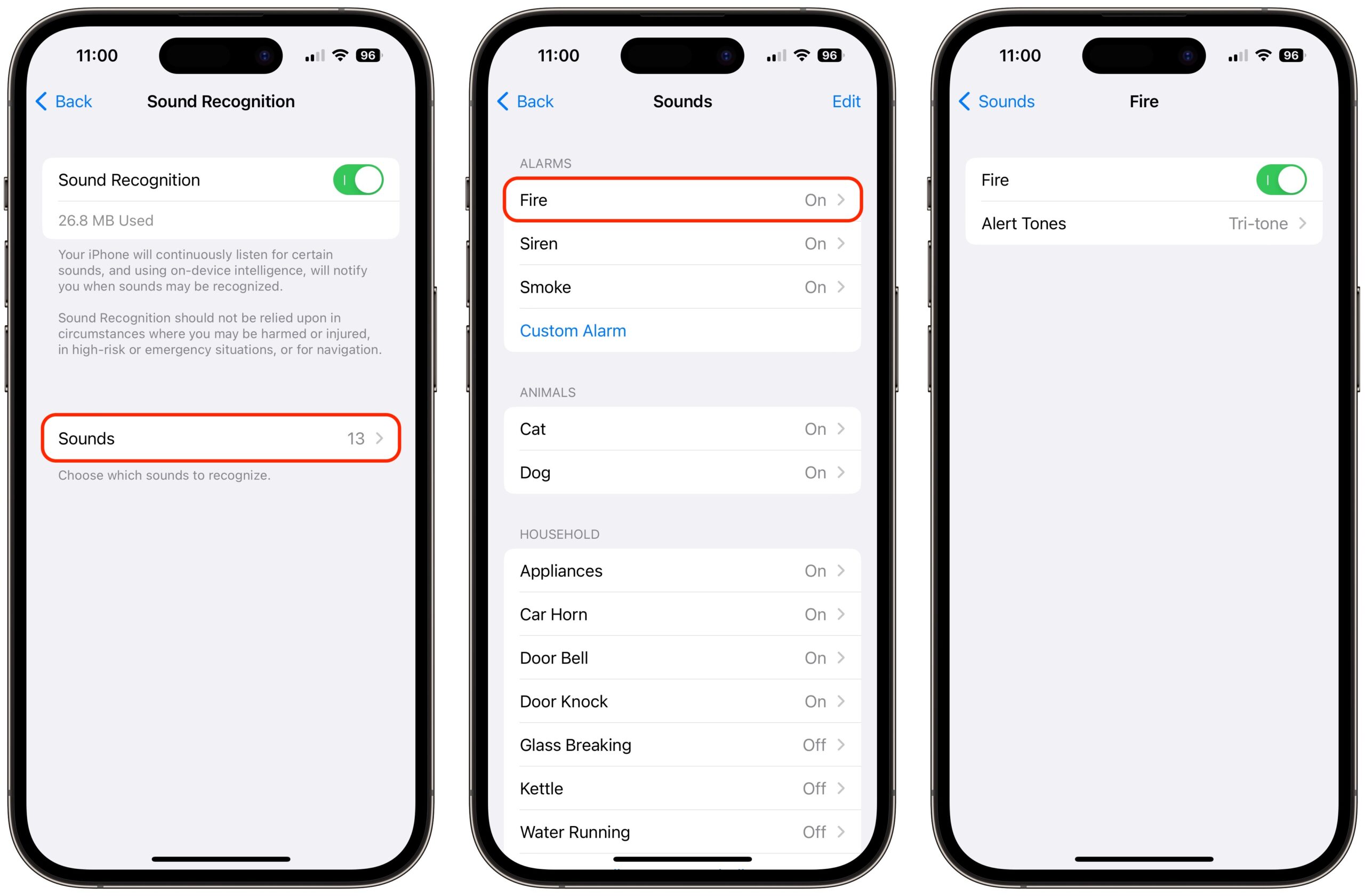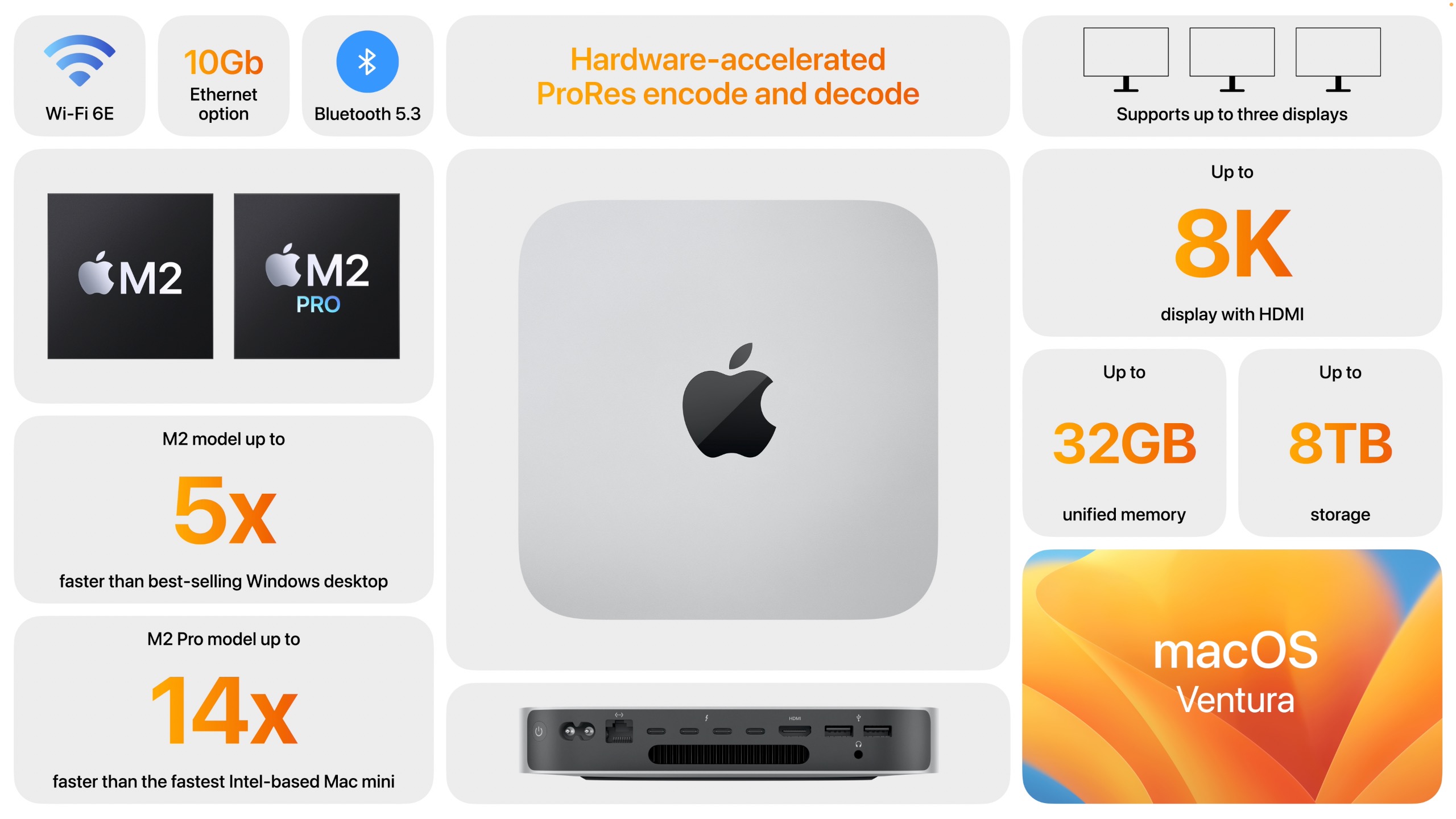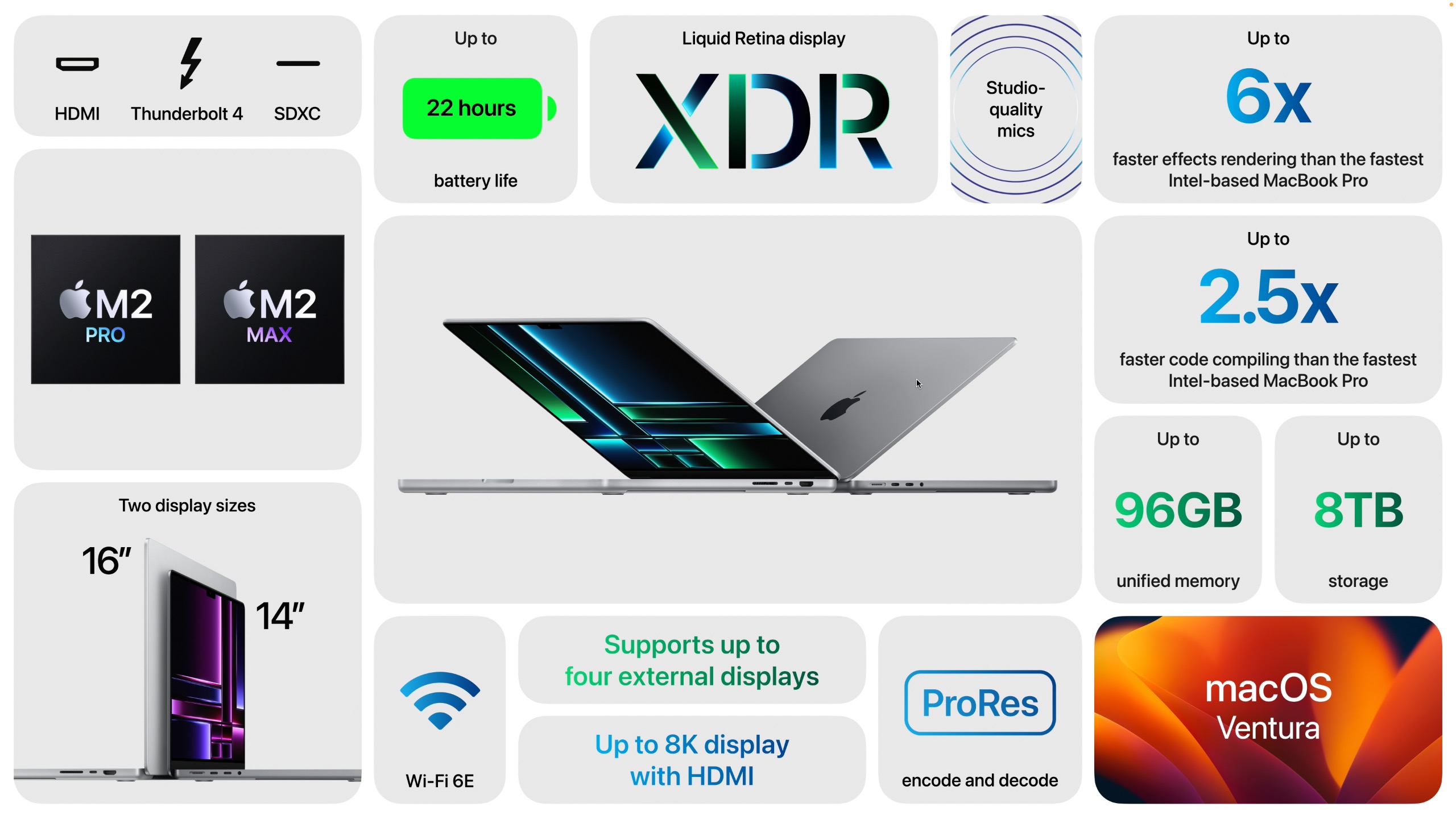#1643: New Mac mini and MacBook Pro models, new second-gen HomePod, security-focused OS updates, industry layoffs
It has been a week of unexpected Apple releases, and we have lots of details for you. First, the company announced new M2 models of the Mac mini and the 14-inch and 16-inch MacBook Pro, with the surprise unveiling of the M2 Pro and M2 Max chips. The next day, Apple announced the second-generation HomePod, bringing back the previously discontinued full-size smart speaker. And hours before we were scheduled to put this issue to bed, Apple released iOS 16.3, iPadOS 16.3, macOS 13.2 Ventura, and watchOS 9.3, plus security-focused updates to iOS 12.5.7, iOS/iPadOS 15.7.3, macOS 11.7.3 Big Sur, macOS 12.6.3 Monterey, and Safari 16.3. Adam Engst also looks briefly at the wave of industry layoffs and how Apple has avoided cutting jobs like all the rest of the tech giants. Other notable Mac app releases this week include BBEdit 14.6.3, Audio Hijack 4.1, Fantastical 3.7.6, Default Folder X 5.7.4, Toast 20.1 Titanium and Pro, Fetch 5.8.3, Firefox 109, and Mimestream 0.41.2.
Apple Releases iOS 16.3, iPadOS 16.3, and macOS 13.2 Ventura with Hardware Security Key Support
Apple’s engineers have been hard at work since the holiday break, since it has been barely a month since the last non-trivial update to the company’s operating systems (see “Apple Releases iOS 16.2, iPadOS 16.2, macOS 13.1 Ventura, watchOS 9.2, and tvOS 16.2,” 13 December 2022). The company has now released iOS 16.3, iPadOS 16.3, macOS 13.2 Ventura, and watchOS 9.3 with one new feature, a new wallpaper and watch face for Black History Month, a collection of bug fixes, and a dose of security updates. Apple said nothing about updates to tvOS or HomePod Software.
The most notable change in iOS 16.3, iPadOS 16.3, and macOS 13.2 is Security Keys for Apple ID, a feature that allows you to strengthen the security of your account by requiring a physical security key to log in. I’ll admit a complete lack of experience with such hardware keys, but the name I hear most frequently is YubiKey, the umbrella name for a variety of hardware keys from Yubico. They’re not particularly expensive, and some even let you authenticate with a fingerprint, just like Touch ID.
Using a security key to protect an Apple ID is overkill for the vast majority of Apple users, but for anyone who’s a high-value target, it could be a welcome addition. Remember, high-value targets aren’t just politicians, high-ranking executives, journalists, and activists—they also include anyone with access to key systems, which could include lower-level IT support staff.
Apart from the addition of Security Keys for Apple ID and support in iOS and iPadOS for the second-generation HomePod (see “Second-Generation HomePod Supports Spatial Audio, Temperature/Humidity Monitoring, and Sound Recognition,” 18 January 2023), these are largely maintenance releases. iOS 16.3, iPadOS 16.3, and macOS 13.2 all fix a bug in the Freeform digital whiteboard app that blocked some drawing strokes created with a finger or an Apple Pencil from appearing on shared boards. Plus, iOS and iPadOS both address an annoying issue that prevented Siri from responding properly to music requests.
You should know about two other iPhone-specific changes. First, to prevent inadvertent emergency calls, Emergency SOS calls now require holding the side button with the up or down volume button and then releasing. It’s not quite clear how this differs from the previous behavior, and I don’t dare test this for fear of actually calling 911. Nevertheless, visit Settings > Emergency SOS, verify your settings, and read the help text. Second, a new Unity wallpaper honors Black history and culture in celebration of Black History Month.
Beyond those changes, iOS 16.3 fixes bugs that:
- Caused the wallpaper to appear black on the Lock Screen
- Temporarily displayed horizontal lines while waking up an iPhone 14 Pro Max
- Blocked the Home Lock Screen widget from accurately displaying Home app status
- Prevented Siri requests in CarPlay from being understood correctly
watchOS 9.3 supposedly gets “new features, improvements and bug fixes,” but the only thing Apple is willing to describe is a new Unity Mosaic watch face to honor Black history and culture in celebration of Black History Month.
Sadly, it doesn’t appear that Apple has changed the requirement to enter a passcode every time an iPhone or iPad tries to back up to a Mac, as we outlined in “iPhones and iPads Now Require a Passcode on Every Backup/Sync” (11 January 2023)
All the operating systems receive security updates as well. As far as Apple is saying, none of the addressed vulnerabilities have been exploited in the wild.
- iOS 16.3 and iPadOS 16.3: 12 security vulnerabilities
- macOS 13.2 Ventura: 22 security vulnerabilities
- watchOS 9.3: 11 security vulnerabilities
Given that the scope of the changes in these updates is quite small and none of the fixed security vulnerabilities are being exploited in the wild, you can take a few days or a week to update—there’s no huge hurry.
iOS 12.5.7 and iOS/iPadOS 15.7.3 Provide Security Fixes
Although Apple doesn’t promise to update older versions of iOS and iPadOS, the company often releases security updates to protect users of devices that can’t update to the latest. To that end, Apple has just released iOS 12.5.7 and iOS/iPadOS 15.7.3.
iOS 12.5.7 addresses a serious security vulnerability in WebKit that could allow maliciously crafted Web content to execute arbitrary code. This vulnerability, which is being exploited in the wild, is the same one that Apple plugged in mid-December for other operating systems (see “Apple Releases iOS 16.2, iPadOS 16.2, macOS 13.1 Ventura, watchOS 9.2, and tvOS 16.2,” 13 December 2022, and “iOS 15.7.2 and iPadOS 15.7.2 Block Exploited Security Vulnerability,” 14 December 2022).
The only reason to delay updating is if you back up your iPhone or iPad to your Mac and are not currently being nagged by a passcode request on every connection (see “iPhones and iPads Now Require a Passcode on Every Backup/Sync,” 11 January 2023). I don’t know if updating will change that behavior (or if devices running iOS 12 are already experiencing it), but it’s worth waiting until someone can test before proceeding. If you back up to iCloud, I recommend updating to iOS 12.5.7 right away.
iOS 15.7.3 and iPadOS 15.7.3 address five security vulnerabilities, none of which are being exploited in the wild. You’ll want to update, but feel free to wait a week or so to make sure no unexpected problems crop up in online discussions.
Apple Avoids Big Tech Layoffs, Other Tech Giants Focus on AI
CNBC has compiled a roundup of all the tech layoffs in the last year:
The job cuts in tech land are piling up, as companies that led the 10-year bull market adapt to a new reality. … The layoffs come in a period of slowing growth, higher interest rates to battle inflation, and fears of a possible recession next year.
When it was just Meta (11,000 jobs cut) and Twitter (3,700) and Snap (1,000), it was easy to think the problem was just with social media. When layoffs hit Coinbase (2,000) and Crypto.com (500), we could hope it was merely the overheated crypto world being exposed to reality, particularly in light of FTX’s ignominious collapse. When Amazon laid off 18,000 employees, it might just have been a correction to the pandemic hiring spree that doubled Amazon’s headcount to 1.6 million by the end of 2021. But now Microsoft has laid off 10,000 workers and Google has cut 12,000, suggesting larger problems in the industry and the economy.
Or perhaps laying off numerous employees is merely a contagious idea that seldom benefits companies. Regardless, dropping 75,000 tech employees into the job market will cause consternation among upcoming 2023 college graduates. I don’t envy all those computer science majors.
Apple remains the only tech giant that hasn’t announced layoffs. Why? Despite strong financial results, Apple has resisted increasing headcount excessively, averaging just 5.6% growth over the last four years. By comparison, Amazon averaged 31.1%, Google 18.3%, Meta 30.3%, and Microsoft 14.1%.
I was also struck that Google, Meta, and Microsoft all reference an increased focus on AI in their letters to employees.
Sundar Pichai of Google:
We have a substantial opportunity in front of us with AI across our products and are prepared to approach it boldly and responsibly.
Mark Zuckerberg of Meta:
As we build our AI infrastructure, we’re focused on becoming even more efficient with our capacity.
Satya Nadella of Microsoft:
At the same time, the next major wave of computing is being born with advances in AI, as we’re turning the world’s most advanced models into a new computing platform.
Even though TidBITS Publishing’s headcount fell by 50% last year (from two to one, in a mutual decision—see “Josh Centers: So Long and Thanks for All the Fish,” 14 November 2022), I can say with assurance that we do not see AI as a substantial opportunity, chance to create more efficient infrastructure, or reason to switch to a new platform. Instead, we plan to double down on our efforts to craft everything we write with HI (human intelligence). Bots can write for other bots; we publish for people.
Second-Generation HomePod Supports Spatial Audio, Temperature/Humidity Monitoring, and Sound Recognition
Continuing the surprise announcements for the week (see “New Mac mini and MacBook Pro Models Powered by M2 Pro and M2 Max,” 18 January 2023), Apple threw back the curtains on a product few people expected—the second-generation HomePod. The new full-size HomePod supports spatial audio with Dolby Atmos for music and video, includes temperature and humidity monitoring, and promises an upcoming Sound Recognition feature for later this year. It comes in white and midnight (which replaces space gray in a distinction with little difference).
Users will be able to leverage the new temperature/humidity sensor in the Home app to create automations that close blinds or control fans automatically based on the ambient environment. Apparently, this capability is also being enabled on the HomePod mini, perhaps in an upcoming HomePod Software update. Other HomeKit-compatible products already provide such sensors, but having the capability built into the HomePod should encourage more people to dabble with smart home automation. The updated HomePod also supports Matter (see “Matter Is Here, but Does It Matter Right Now?,” 4 November 2022).
More interesting is the new Sound Recognition feature. It enables the HomePod to listen for smoke and carbon monoxide alarms and send a notification to the user’s iPhone when the sound is detected. The feature is a focused use of what’s in iOS in Settings > Accessibility > Sound Recognition, which can recognize various sounds and alert the user. However, Apple says it won’t be available until a software update that arrives “this spring.” It will also require the new Home architecture, which Apple released with iOS 16.2 and promptly pulled a few days later (see “Apple Releases iOS 16.2, iPadOS 16.2, macOS 13.1 Ventura, watchOS 9.2, and tvOS 16.2,” 13 December 2022).
You can still configure two HomePods to create a stereo pair, but note that the feature requires two HomePods of the same model. So you can’t pair an original HomePod with a second-generation model or mix a HomePod mini with either.
The second-generation HomePod is available to order now for $299, the same price as the original HomePod, and will ship starting 3 February 2023.
A Triumphant Return?
After years of disappointing sales, Apple dropped the original HomePod from the lineup in 2021—see “Apple Discontinues Original HomePod, Focuses on HomePod mini” (15 March 2021). As I wrote in that article:
Although the HomePod was a tremendous feat of engineering and delivered excellent sound, it wasn’t price-competitive with smart speakers from Amazon and Google at either its original price of $349 or the $299 to which Apple later dropped it.
So why did Apple bring back the full-size HomePod, and why now? A close comparison of the specs shows that Apple trimmed the parts list for the second-generation HomePod to lower the cost of production and increase the profit margin. While retaining a very similar industrial design (it’s 4 mm shorter and 200 g lighter), the second-generation HomePod has the following:
- An array of five—down from seven—horn-loaded tweeters (the world only stands to benefit from fewer horn-loaded tweeters anyway)
- An array of four—down from six—microphones for far-field Siri
- 802.11n Wi-Fi instead of the 802.11ac Wi-Fi in the previous model
There are other differences as well, though it’s hard to know whether they reflect less expensive parts or are merely different ways of describing similar capabilities. For instance, the first-generation HomePod has a “high-excursion woofer with custom amplifier,” while the second-generation model advertises only a “4-inch high-excursion woofer.” Similarly, each original horn-loaded tweeter (I can’t express how much I enjoy visualizing the phrase “horn-loaded tweeter”) had its own “custom amplifier,” whereas each of the new ones has a “neodymium magnet.” Cheaper? Better? More jargony? If you’re an audio engineer, please speculate in the comments.
Apple says the second-generation HomePod is powered by the S7 chip, likely backed up by a U1 chip for Ultra Wideband support (for tapping a U1-equipped iPhone to the top of the HomePod to transfer audio). The original HomePod had an A8 chip (see “HomePod Arrives February 9th, Multi-Room Audio to Follow Later in 2018,” 23 January 2018), whereas the cheaper HomePod mini relies on the S5 and U1 chips (see “Apple Introduces $99 HomePod mini,” 13 October 2020). I suspect that the S7, which powers the Apple Watch, is far less expensive than the A8 was back in 2018. It’s also the reason for dropping from 802.11ac to 802.11n—the latter is all that’s supported by the S7 chip.
My guess is that Apple found that it could leverage the computational power of the S7 to provide the same level of sound quality and Siri responsiveness even with less hardware. Given the kind of scale that Apple can bring to manufacturing, the company presumably was able to make this new HomePod sufficiently profitable to warrant bringing it back. Of course, the question is if the new HomePod’s quality and performance are as good as the original’s—I’m sure we’ll get comparisons soon.
Apple took a lot of flak for the initial $349 price of the original HomePod, and even at $299, it didn’t compete well against much cheaper smart speakers from Amazon and Google. That prompted the development of the $99 HomePod mini and the discontinuation of the original HomePod.
But late last year, news reports revealed that Amazon’s hardware team was on pace to lose $10 billion in 2022. Although the Echo speakers were among the best-selling devices on Amazon, most were sold at cost. That’s better than losing money on each sale but making up for it in volume, but not a lot. So Apple’s willingness to charge a price that reflected its costs was probably more sensible, if not effective for garnering market share.
New Mac mini and MacBook Pro Models Powered by M2 Pro and M2 Max
Surprise! We’re not accustomed to mid-January releases from Apple since the demise of Macworld Expo, but the company returned to the schedule of yesteryear to unveil its new M2 Pro and M2 Max chips and the Macs they power. New Mac mini models sport the M2 and the M2 Pro, and new MacBook Pro models are powered by the M2 Pro and M2 Max. You can also watch the 19-minute intro video.
All these Macs are available to order now and will ship and arrive in stores on 24 January 2023. Customers in Australia, China, Hong Kong, Japan, Macau, New Zealand, and Singapore will have to wait until 3 February 2023 to receive their orders.
M2 Pro and M2 Max
First up, the chips. As with their M1-family predecessors, the M2 Pro and M2 Max are expanded versions of the base M2.
- The M2 Pro offers a 10-core or 12-core CPU and a 16-core or 19-core GPU. It also includes either 16 GB or 32 GB of on-chip unified memory that works at 200 gigabytes per second.
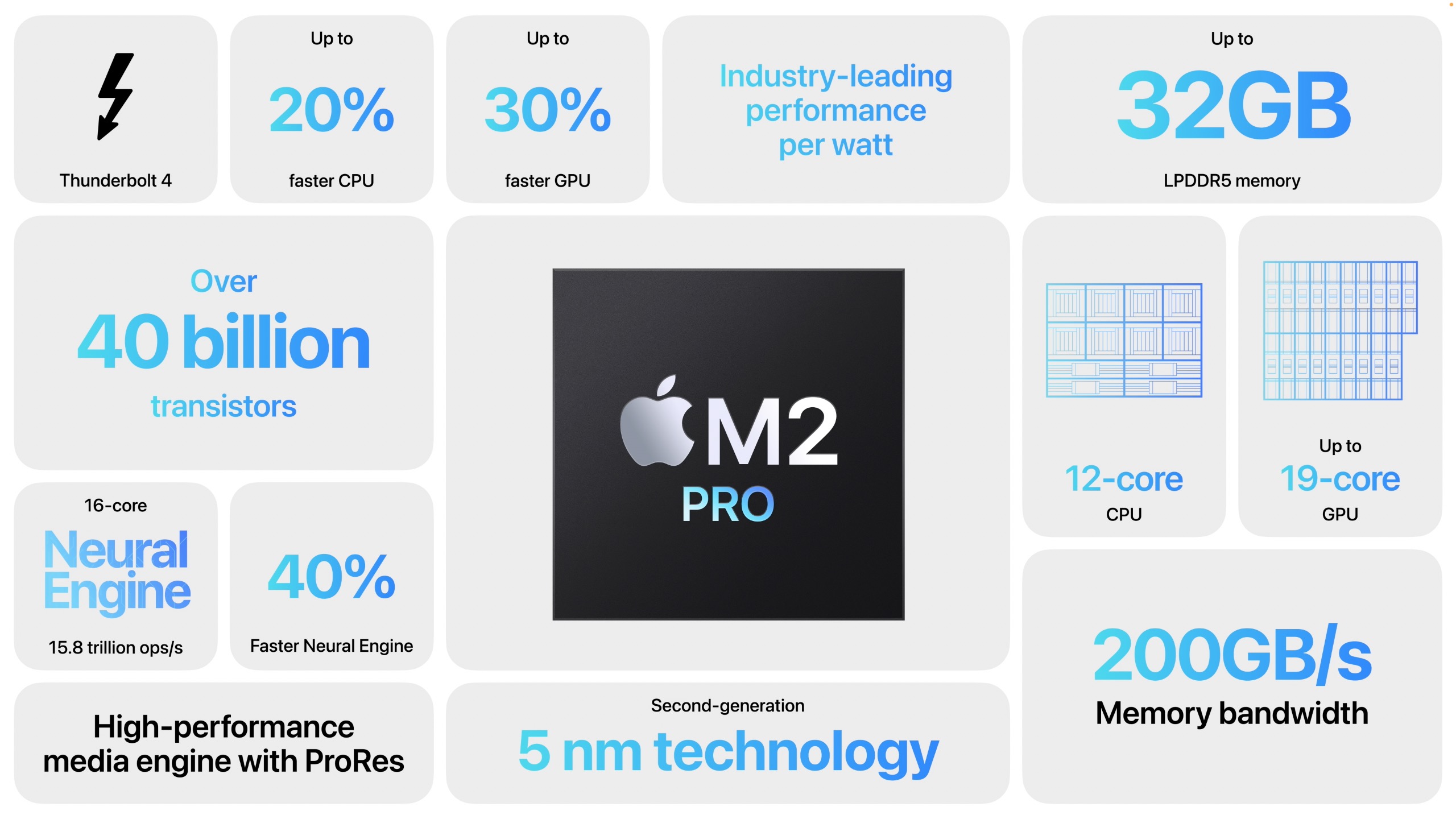
- The M2 Max has a 12-core CPU with either a 30-core or 38-core GPU. Unified memory options include 32 GB, 64 GB, and—with the 38-core GPU model—96 GB.
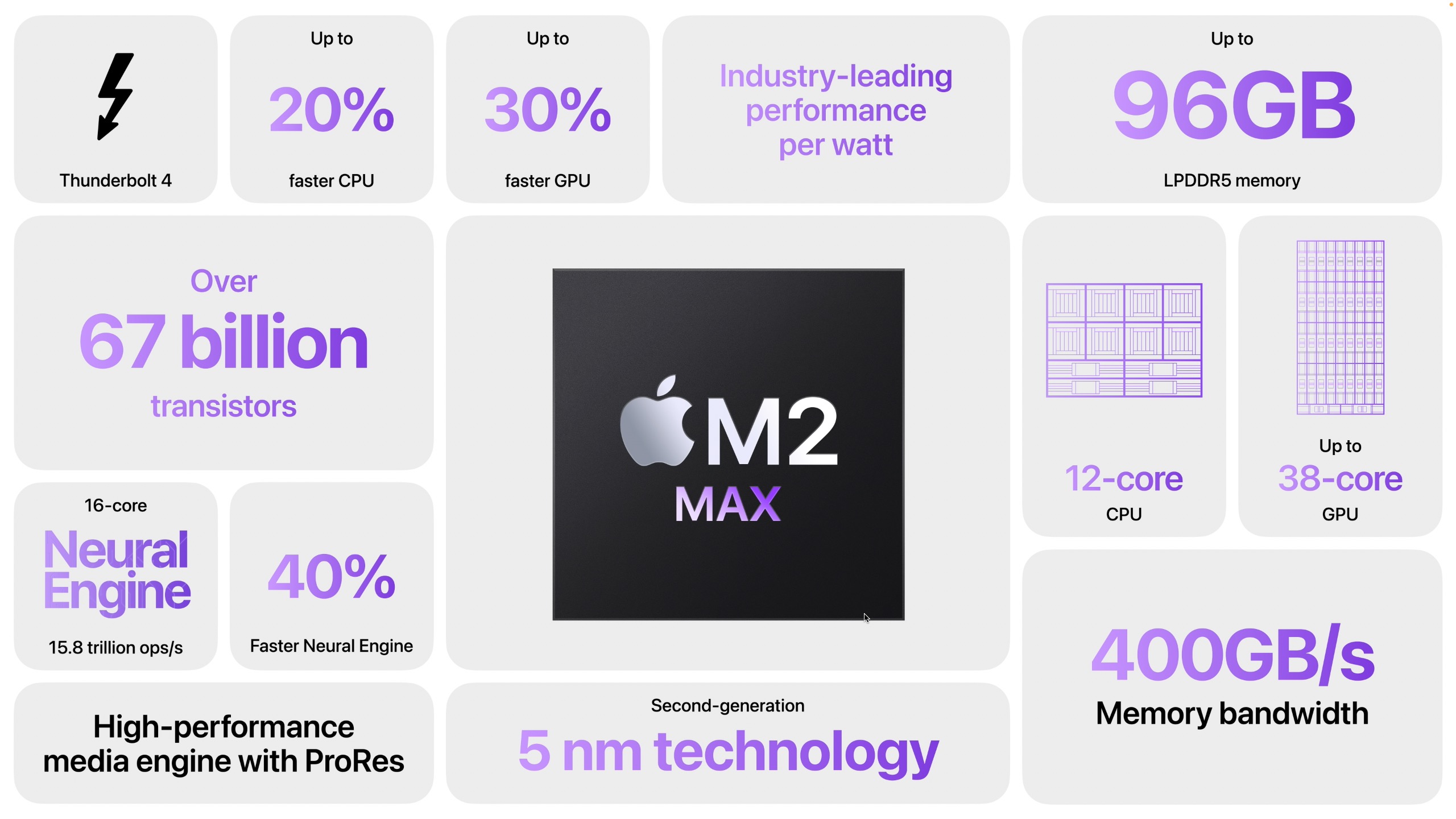
Apple said that both chips provide 20% better CPU performance than their M1 counterparts, 30% better GPU performance, and 40% better Neural Engine performance. In specific app benchmarks, Apple claims improvements of 25%–40%. We’ll see if those claims hold up in real-world testing, where the M2 proved about 15%–20% faster than the M1.
Regardless, it seems that the M2 Pro and M2 Max do pretty much what everyone expected in terms of improving on the M1 Pro and M1 Max. So, how is Apple using these chips?
Mac mini with M2 and M2 Pro
No one watching the Mac mini was surprised that Apple announced an M2 Mac mini—that writing was on the wall as soon as the M2 chip debuted with the MacBook Air and 13-inch MacBook Pro (see “Apple Unveils M2-Powered MacBook Air and Updated 13-Inch MacBook Pro,” 6 June 2022). Even more welcome, however, is the addition of a reasonably priced M2 Pro Mac mini that brings Apple’s diminutive desktop Mac to an audience that wanted more power than the M1 Mac mini but didn’t want to jump to the Mac Studio.
How do the two models compare?
- The M2 Mac mini starts at $599 and provides an 8-core CPU and 10-core GPU with unified memory configurations of 8 GB, 16 GB ($200), or 24 GB ($400). In terms of storage, the base level is 256 GB, but you can increase that to 512 GB ($200), 1 TB ($400), or 2 TB ($800). It provides only two Thunderbolt 4 ports.
- The M2 Pro Mac mini starts at $1299 for a 10-core CPU and 16-core GPU, but you can bump that up to an M2 Pro with a 12-core CPU and 19-core GPU for $300. You also get 16 GB of unified memory and 512 GB of storage for that base price. 32 GB of memory is $400 more, and storage upgrades are 1 TB ($200), 2 TB ($600), 4 TB ($1200), and 8 TB ($2400). It offers more connectivity options with four Thunderbolt 4 ports.
Of course, the Mac mini lacks a built-in screen. Happily for multiple-monitor mavens, Apple enhanced external display support such that even the M2 Mac mini supports two displays: one at up to 6K resolution over Thunderbolt and another at 5K resolution over Thunderbolt or 4K resolution over HDMI.
When you mix an M2 Pro with Apple’s latest HDMI support, things become even more interesting for those who need either ultra-high resolutions or extremely fast refresh rates. The M2 Pro Mac mini can drive up to three displays: two at up to 6K resolution over Thunderbolt and a third at 4K resolution over HDMI. However, if you connect only two displays to the M2 Pro Mac mini, it can drive one at 6K resolution over Thunderbolt and the second one at 4K resolution at 144 Hz over HDMI. Drop to a single display over HDMI, and it can run either at 8K resolution at 60 Hz or 4K resolution at 240 Hz. Let us know in the comments if 8K resolution or 144/240 Hz refresh rates are important to you, and why.
On both Mac mini models, Gigabit Ethernet is standard, and 10 Gigabit Ethernet adds $100. Along with the two or four Thunderbolt 4 ports and the HDMI port, both models include two USB-A ports and a 3.5 mm headphone jack. In terms of wireless connectivity, the new Mac mini models support the latest Wi-Fi 6E, which takes advantage of a new swath of unlicensed spectrum in the 6 GHz band to offer faster performance over short distances with new Wi-Fi 6E-capable routers. They also have Bluetooth 5.3, which might improve the Bluetooth experience.
Putting it all together, these updates to the Mac mini may change your buying equations. The M2 Mac mini becomes even more of a solid entry-level desktop Mac thanks to the M2’s improved performance, the option for 24 GB of memory, and Apple dropping the price by $100 to $599.
More interesting is the M2 Pro Mac mini, which provides significantly more performance in the Mac mini form factor, along with higher memory and storage ceilings and more Thunderbolt ports. The real question for those considering a purchase soon becomes how a tricked-out M2 Pro Mac mini compares with an M1 Max Mac Studio. AppleInsider has compared the two, and if you’re considering either, you’ll want to build your own comparison sheet. Of course, Apple is sure to update the Mac Studio with the M2 Max and eventual M2 Ultra at some point in the next 6–12 months, which will give the Mac Studio a more significant performance edge, particularly if Apple doesn’t raise its prices. And who knows, maybe Apple will eventually release the promised Mac Pro with Apple silicon—maybe it will be essentially an M2 Ultra Mac Studio in a case that provides internal expansion options.
One final note—Apple quietly dropped the Intel-based Mac mini from the product line, leaving the Mac Pro as the remaining remnant of the Intel chip era.
14-inch and 16-inch MacBook Pro with M2 Pro and M2 Max
With its new 14-inch and 16-inch MacBook Pro models, Apple changed only the laptops’ innards, upgrading their chips to the M2 Pro and M2 Max and modernizing the wireless connectivity to Wi-Fi 6E and Bluetooth 5.3. For a longer discussion of the basic features, see “New 14-inch and 16-inch MacBook Pros Powered by M1 Pro and M1 Max Chips” (18 October 2021).
So, what do you get?
- The 14-inch MacBook Pro starts at $1999 for an M2 Pro with a 10-core CPU and 16-core GPU, 16 GB of memory, and 512 GB of storage. Chip upgrades include the 12/19-core (CPU/GPU) M2 Pro ($300), the 12/30 M2 Max ($500), and the 12/38 M2 Max ($700). With memory, the M2 Pro configurations can upgrade to 32 GB ($400), whereas the M2 Max configurations start at 32 GB and let you go to 64 GB ($400) or 96 GB ($800, with the 12/38 M2 Max only).
- The 16-inch MacBook Pro is $2499 for an M2 Pro with a 12-core CPU and 19-core GPU, 16 GB of memory, and 512 GB of storage. Chip upgrades include the 12/30 M2 Max ($200) and the 12/38 M2 Max ($400). Memory is the same as with the 14-inch MacBook Pro, so the M2 Pro configuration can upgrade to 32 GB ($400), and the M2 Max configurations start at 32 GB and let you go to 64 GB ($400) or 96 GB ($800, with the 12/38 M2 Max only).
Along with the improved wireless connectivity, both MacBook Pro models have a MagSafe 3 charging port, HDMI for connecting a display, an SDXC card slot, a 3.5 mm headphone hack, and three Thunderbolt 4 ports (two on the left, one on the right).
As with the new Mac mini models, the new MacBook Pro models boast better external display support thanks to the M2 Pro and M2 Max coupled with improved HDMI capabilities. Configure one with an M2 Pro and, in addition to its built-in display, it supports either:
- Up to two external displays with up to 6K resolution over Thunderbolt, or one at up to 6K resolution over Thunderbolt and another with 4K resolution at 144 Hz over HDMI
- One external display at 8K resolution at 60 Hz or one at 4K resolution at 240 Hz over HDMI
With an M2 Max, you can drive either:
- Up to four external displays, three at up to 6K resolution over Thunderbolt and one at 4K resolution at 144 Hz over HDMI
- Up to three external displays, two at up to 6K resolution over Thunderbolt and one at either 8K resolution at 60 Hz or 4K resolution at 240 Hz over HDMI
As impressive as the specs are on these new MacBook Pro models, they change buying decisions only in the sense of giving those waiting for the next entrants in the M2 family freedom to get off the fence. If you’ve been holding out for an M2 Pro or M2 Max laptop, wait no longer.
